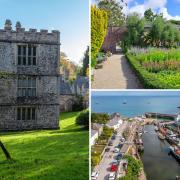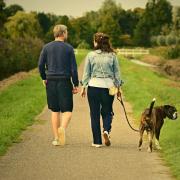Cornwall is no slouch when it comes to providing lush settings to our film industry and the latest puts Cornwall up front and centre as one of its stars. On the eve of its release, CAROL BURNS catches up with The Fold’s director John Jencks

Anyone who has travelled around Cornwall will recognise the backdrops of the new film The Fold, which is released in cinemas on 28 March.
The film features such locations as St Winwalloe church, The Lizard and Praa Sands near Helston and makes Cornwall’s scenery look truly stunning.
“It’s a story about a woman moving to start a new life after the death of one of her daughters,” explains US-born director John Jencks. “She arrives in Cornwall with her surviving daughter and starts afresh. She meets a young woman who works in the daffodil harvest and becomes a surrogate mother-daughter relationship.
“Rebecca, our main character is running away from the death of her daughter - and a lot of people go to Cornwall to escape things: you can go and be your own person; you can reinvent yourself; find a new identity.”
Rebecca Ashton (Catherine McCormack) is the Anglican priest and grieving mother who takes over the ministry of a local church (filmed at St Winwalloe Church, The Lizard). It is here that she finds a Bulgarian girl, Radka (Marina Stoimenova), sleeping rough. Reminded of her deceased daughter, Rebecca offers to become Radka’s guardian but neglects to tell her she has another daughter, Eloise (Dakota Blue Richards).
As the three women struggle for their lives, Rebecca is forced to come to her senses and embrace the reality of this dangerous situation. The name of the film, The Fold, relates to the place in the heart that we fold up painful memories, explains John.
The idea for a film based around someone being stalked took on a new direction, he says, when they approached writer Poppy Cogan, a regular to Cornwall throughout her life. She immediately saw the potential of using Cornwall, John admits. “She spent all her summers down her, and she naturally picked up on the Cornish setting,” explains John. And the county has become the star of the film - at a recent preview screening of the film in London the general consensus of the audience was they want to go there - now.
Cornwall is fundamental to the film, says John, and plays a huge part in telling the story. They picked up quickly on the daffodil harvest. “It has a really strong cinematic feel to it,” says John. They filmed daffodil farms at Millpool and Mallingoose where Radka works.
The setting also reflected the tone of the film, using the natural environment to reflect the story. “The depression of the character is reflected in the grey granite and gorse, and lifts with the brightness of the daffodils,” adds John. The backdrop also reflects the isolation of the character in the beginning, and the coastline was used as the story reaches its dramatic peak.
“Our director of photography kept going on about the lovely balance of light – the sea balancing the light and lifting the shadows,” he continues. “We could only have found that visual landscape in Cornwall.”
For the sharp-eyed among you:
Daffodil farms at Chyrase Farm, Millpool, Penzance TR20 9JD and Penvose Tregony and Mallingoose Tregony Rebecca’s house in the film is Cove Cottage, Gunards Head, St Ives, TR26 3DE. The story goes that the current owners have this property on squatters’ rights, living in an empty, decaying shell of a house for years before it became theirs by default and they could do it up. Church Cove, The Lizard. National Trust. – where Radka runs when she escapes the church after Rebecca finds her there. Dollar Beach, The Lizard. National Trust. – where the band play and Eloise and Jakub kiss. Also where Eloise and Rebecca run into the sea. When we finished the shoot here, in solidarity with Catherine McCormack and Dakota Blue Richards who had gone into the sea, director John Jencks ran into the freezing cold sea. It’s captured on camera somewhere… Kynance Cove, The Lizard. National Trust. – the beach near-drowning sequence location: this was the hardest location to shoot in. The crew used flatbed trucks to ferry cast and crew as far down as vehicles can go, and then go on foot down the slippery cliff paths with equipment and watch the tides to stop the crew getting stranded on sections of the beach. St Winwalloe Church, The Lizard – Rebecca’s church. Truro Cathedral – the crew describe their time there as a magical day on set. The atmosphere in the cathedral is extraordinary. Truro Cathedral had always been a really important place in the script and was written in a lot of detail.
Praa Sands – this beach was used as an additional location for the final beach sequence, as the location is much easier to access, safer and the waves calmer. The film intercuts between Praa Sands and Kynance Cove but you can’t tell – magic of the movies!



























